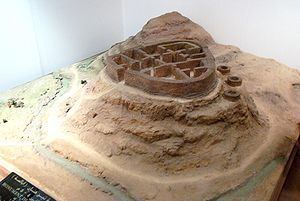Burials Tin Hinan | ||
 | ||
Architectural style Ancient Roman architecture Similar Jedars, Arch of Caracalla, Mr Belhassen mosque, Bardo National Museum, Arch of Trajan | ||
Tin hinan
Tin hinan (or Tin hinan tomb) is a monumental tomb located in the Sahara at Abalessa in the Hoggar Mountains of southern Algeria. The sepulchre was built for the Tuareg matriarch Tin Hinan, an ancient Queen of the Hoggar. The tomb is believed to have been constructed over a Roman fortification made by Lucius Cornelius Balbus during the reign of Augustus.
Contents
History
According to Henri Lhote, the Tin Hinan sepulchre is different from the surrounding tombs in southern Algeria, and is more typical of the architecture used by the Roman legionaries to create their fortifications in desert areas. He believes that the tomb was therefore likely built on top of an earlier Roman castrum, which was originally erected around 19 BC, when consul Lucius Cornelius Balbus conquered the Garamantian territories and sent a small expeditionary force to reach the Niger river.
Pliny, the Roman historian, wrote of a Roman raid deep into the Sahara led by Cornelius Balbus. One of the places he captured was called "Balsa" (may be the ancient name for actual Abalessa). As soon as the Romans had left, their fortification would be useless to the native rulers: they had no immediate enemies here in the heart of the Sahara desert. But such an impressive building would make a fitting tomb for their great Queen Tin Hinan, some centuries later.
The outer walls of the tomb (of Tin Nunan) must have covered an area of sixty by ninety feet, and later we discovered that the walls themselves were about three feet thick at the highest remaining point. The walls of the smaller tombs were from eighteen inches to two feet thick. Byron Khun de Prorok
Gabriel Camps in 1965 pinpointed that the stones (even more than 3 feet thick) used in the tomb were too much heavy to be moved by desert men on the hill where they are now, and this indicates clearly that the builders were not locals but "foreigners".
Furthermore, the Romans returned to the area when emperor Septimius Severus defeated again the Garamantes around 205 AD and attempted the creation of the Roman province of Phasania (approximately actual Fezzan and surroundings). Information about this tentative is not extensive, but it is known that Romans wanted to control the trans-Saharan commerce and probably favoured the settlement of their traders and people in order to control the region. Some Romanised Berbers moved in those years from the coast to this area, and Tin Hinan (and/or her parents) could have been one of them.
Tin Hinan is the name given by the Tuareg to a 3rd- or 4th-century woman of prestige whose skeleton was found in a pre-Islamic tomb in the Ahaggar mountains. The name means literally "She of the tents", but may be metaphorically translated as "Mother of the tribe" (or "of us all") or even "Queen of the camp" (the "camp" maybe referring to the group of tombs which surround hers). She is sometimes referred to as "Queen of the Hoggar", and by the Tuareg as Tamenukalt which also means "leader" or "queen".
The tomb was opened by Byron Khun de Prorok with support from the French army in 1925, and other archaeologists made a more thorough investigation in 1933. It was found to contain the skeleton of a woman on a wooden litter, lying on her back with her head facing east. She was accompanied by heavy gold and silver jewellery, some of it adorned with pearls. On her right forearm she wore 7 silver bracelets, and on her left, 7 gold bracelets. Another silver bracelet and a gold ring were placed with the body. Remains of a complex piecework necklace of gold and pearls (real and artificial) were also present Furthermore, a number of funerary objects were also found. These included a "Venus" statue in Aurignacian style (similar to the Venus of Hohle Fels), a glass goblet (lost during World War II), and gold foil which bore the imprint of a Roman coin of emperor Constantine I issued between 308 and 324 AD. A fourth century date is consistent with carbon dating of the wooden bed and also with the style of pottery and other tomb furniture. The tomb itself is constructed in a style that is widespread in the Berber Sahara during classical times.
An anthropological study of the remains -published in 1968 by Leblanc- concluded the skeleton was that of a woman 1.72 to 1.76 metres tall, belonging to a white female, who had probably never had children and who was probably lame because of deformation of the lumbar and sacral areas.
